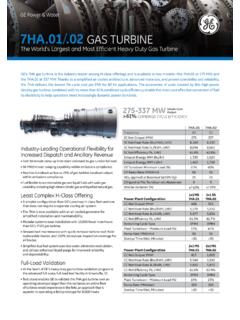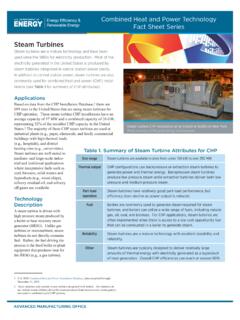Transcription of 3.1 Stationary Gas Turbines
1 Stationary Gas Turbines General1. Gas Turbines , also called combustion Turbines , are used in a broad scope of applications including electric power generation, cogeneration, natural gas transmission, and various process applications. Gas Turbines are available with power outputs ranging in size from 300 horsepower (hp) to over 268,000 hp, with an average size of 40,200 The primary fuels used in gas Turbines are natural gas and distillate (No. 2) fuel Process Description1,2. A gas turbine is an internal combustion engine that operates with rotary rather than reciprocating motion.
2 Gas Turbines are essentially composed of three major components: compressor, combustor, and power turbine . In the compressor section, ambient air is drawn in and compressed up to 30 times ambient pressure and directed to the combustor section where fuel is introduced, ignited, and burned. Combustors can either be annular, can-annular, or silo. An annular combustor is a doughnut-shaped, single, continuous chamber that encircles the turbine in a plane perpendicular to the air flow. Can-annular combustors are similar to the annular; however, they incorporate several can-shaped combustion chambers rather than a single continuous chamber.
3 Annular and can-annular combustors are based on aircraft turbine technology and are typically used for smaller scale applications. A silo (frame-type) combustor has one or more combustion chambers mounted external to the gas turbine body. Silo combustors are typically larger than annular or can-annular combustors and are used for larger scale applications. The combustion process in a gas turbine can be classified as diffusion flame combustion, or lean- premix staged combustion. In the diffusion flame combustion, the fuel/air mixing and combustion take place simultaneously in the primary combustion zone.
4 This generates regions of near-stoichiometric fuel/air mixtures where the temperatures are very high. For lean-premix combustors, fuel and air are thoroughly mixed in an initial stage resulting in a uniform, lean, unburned fuel/air mixture which is delivered to a secondary stage where the combustion reaction takes place. Manufacturers use different types of fuel/air staging, including fuel staging, air staging, or both; however, the same staged, lean-premix principle is applied. Gas Turbines using staged combustion are also referred to as Dry Low NOX. combustors.
5 The majority of gas Turbines currently manufactured are lean-premix staged combustion Turbines . Hot gases from the combustion section are diluted with additional air from the compressor section and directed to the power turbine section at temperatures up to 2600oF. Energy from the hot exhaust gases, which expand in the power turbine section, are recovered in the form of shaft horsepower. More than 50 percent of the shaft horsepower is needed to drive the internal compressor and the balance of recovered shaft horsepower is available to drive an external Gas Turbines may have one, two, or three shafts to transmit power between the inlet air compression turbine , the power turbine , and the exhaust turbine .
6 The heat content of the exhaust gases exiting the turbine can either be discarded without heat recovery (simple cycle ); recovered with a heat exchanger to preheat combustion air entering the combustor (regenerative cycle ); recovered in a heat recovery steam generator to raise process steam, with or without supplementary firing (cogeneration); or recovered, with or without supplementary firing, to raise steam for a steam turbine Rankine cycle (combined cycle or repowering). 4/00 Stationary Internal Combustion Sources The simple cycle is the most basic operating cycle of gas Turbines with a thermal efficiency ranging from 15 to 42 percent.
7 The cycle thermal efficiency is defined as the ratio of useful shaft energy to fuel energy input. Simple cycle gas Turbines are typically used for shaft horsepower applications without recovery of exhaust heat. For example, simple cycle gas Turbines are used by electric utilities for generation of electricity during emergencies or during peak demand periods. A regenerative cycle is a simple cycle gas turbine with an added heat exchanger. The heat exchanger uses the turbine exhaust gases to heat the combustion air which reduces the amount of fuel required to reach combustor temperatures.
8 The thermal efficiency of a regenerative cycle is approximately 35 percent. However, the amount of fuel efficiency and saving may not be sufficient to justify the capital cost of the heat exchanger, rendering the process unattractive. A cogeneration cycle consists of a simple cycle gas turbine with a heat recovery steam generator (HRSG). The cycle thermal efficiency can be as high as 84 percent. In a cogeneration cycle , the steam generated by the HRSG can be delivered at a variety of pressures and temperatures to other thermal processes at the site. For situations where additional steam is required, a supplementary burner, or duct burner, can be placed in the exhaust duct stream of the HRSG to meet the site's steam requirements.
9 A combined cycle gas turbine is a gas turbine with a HRSG applied at electric utility sites. The gas turbine drives an electric generator, and the steam from the HRSG drives a steam turbine which also drives an electric generator. A supplementary-fired boiler can be used to increase the steam production. The thermal efficiency of a combined cycle gas turbine is between 38 percent and 60 percent. Gas turbine applications include gas and oil industry, emergency power generation facilities, independent electric power producers (IPP), electric utilities, and other industrial applications.
10 The petroleum industry typically uses simple cycle gas Turbines with a size range from 300 hp to 20,000 hp. The gas turbine is used to provide shaft horsepower for oil and gas production and transmission. Emergency power generation sites also utilize simple cycle gas Turbines . Here the gas turbine is used to provide backup or emergency power to critical networks or equipment. Usually, gas Turbines under 5,000. hp are used at emergency power generation sites. Independent electrical power producers generate electricity for resale to larger electric utilities. Simple, regenerative, or combined cycle gas Turbines are used at IPP; however, most installations use combined cycle gas Turbines .














